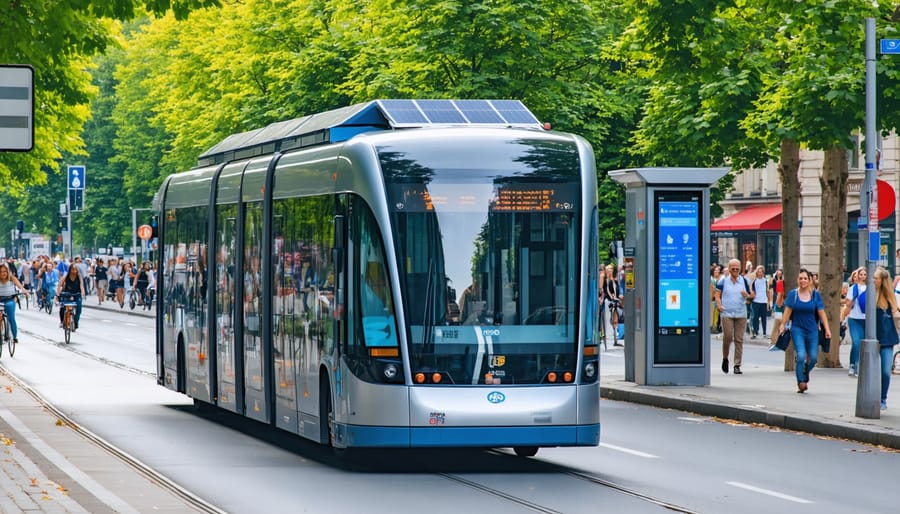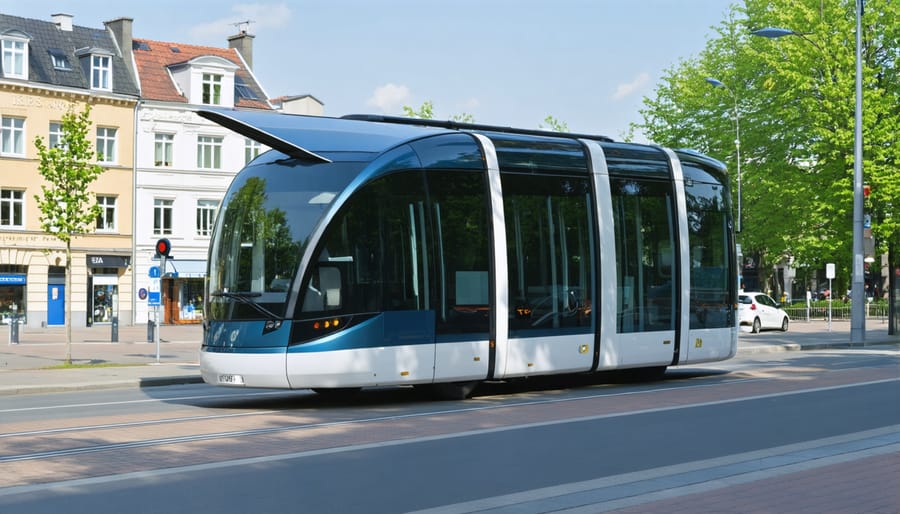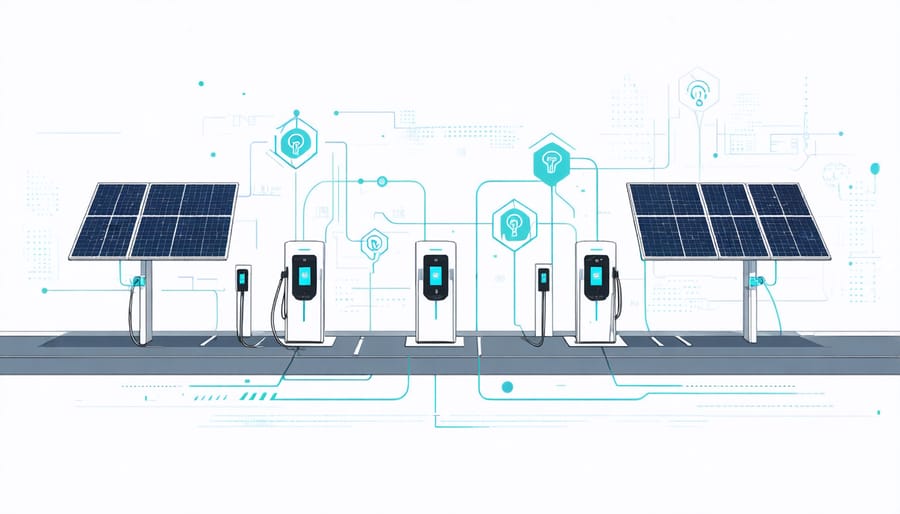Solar-Powered Transit is Transforming European City Transport

Urban mobility stands at the crossroads of innovation and necessity as European cities grapple with unprecedented transportation challenges. The convergence of sustainable technology, smart infrastructure, and environmental imperatives has sparked a revolution in how we envision city transport. From electric vehicle networks to intelligent traffic management systems, urban mobility solutions are transforming our cities into more liveable, efficient, and environmentally conscious spaces.
Smart mobility innovations are already reshaping major European metropolises, with solar-powered charging stations, autonomous vehicles, and integrated transport apps becoming increasingly commonplace. These solutions not only address pressing concerns about carbon emissions and traffic congestion but also demonstrate how renewable energy can power the future of urban transportation.
As cities continue to grow and evolve, the integration of sustainable mobility solutions becomes not just an option but a necessity. The European Union’s commitment to carbon neutrality by 2050 has accelerated the adoption of clean transportation technologies, with solar power playing a pivotal role in this transformation. This shift towards sustainable urban mobility represents more than just technological advancement – it’s a fundamental reimagining of how people and goods move through our cities.
The Rise of Solar-Powered Urban Transport
Solar-Powered Public Transit
The integration of solar power into public transit systems represents a significant leap forward in sustainable urban mobility. As solar-powered buses transform European cities, we’re witnessing a revolution in clean transportation. These innovative vehicles feature advanced photovoltaic panels on their roofs, contributing to their power needs while reducing operational costs and environmental impact.
Modern solar trams are particularly successful in regions with high solar exposure, utilizing both onboard panels and solar-equipped stations for continuous power supply. The charging infrastructure combines strategically placed solar canopies at depots with smart grid integration, ensuring reliable service even during less sunny periods.
Key implementations include solar-thermal cooling systems for passenger comfort, regenerative braking technology that captures and stores energy, and intelligent power management systems that optimize energy usage based on route demands and weather conditions. Cities are also installing solar-powered information displays and ticketing systems at transit stops, creating a comprehensive eco-friendly transit ecosystem.
This solar integration in public transport not only reduces carbon emissions but also serves as a visible demonstration of sustainable technology in action, encouraging wider adoption of renewable energy solutions in urban environments.

Personal Mobility Solutions
Solar-powered personal mobility solutions are revolutionising urban transport across Europe. E-bikes and scooters equipped with integrated solar charging capabilities are becoming increasingly prevalent, offering sustainable alternatives for short-distance travel. These vehicles feature compact solar panels that supplement traditional charging methods, extending their range and reducing dependency on grid electricity.
Smart charging stations powered by solar energy are being installed throughout major European cities, creating a network of sustainable refueling points. These stations often incorporate weather-protected solar panels and efficient energy storage systems, ensuring reliable charging capability even during cloudy periods. Many municipalities are integrating these charging points with existing public transport infrastructure, creating seamless mobility hubs.
The latest generation of solar e-bikes can achieve ranges of up to 70 kilometers on a single charge, while solar-assisted scooters typically offer 30-40 kilometers of travel distance. Advanced energy management systems optimize power consumption and solar charging, while smart connectivity features allow users to locate nearby charging stations and monitor their vehicle’s energy status through mobile applications. This integration of solar technology with personal mobility devices represents a significant step toward sustainable urban transportation solutions.
Infrastructure Integration
Solar Charging Networks
The integration of urban solar charging networks represents a crucial advancement in sustainable city transportation infrastructure. These networks combine strategically placed solar panels with smart charging stations throughout urban areas, creating a self-sustaining ecosystem for electric vehicles and other mobility solutions.
European cities like Amsterdam and Copenhagen are leading the way with comprehensive charging networks powered by solar energy. These systems typically feature dual-function structures that serve both as shade-providing elements and solar collection points, maximizing urban space utility while generating clean energy for charging stations.
The implementation process involves careful planning of charging point distribution, considering factors such as population density, traffic patterns, and existing electrical infrastructure. Modern networks incorporate smart grid technology to optimize energy distribution and storage, ensuring reliable charging availability even during peak demand periods.
Key components include high-efficiency solar panels, energy storage systems, and intelligent charging stations with real-time monitoring capabilities. Many cities are also implementing mobile apps that help users locate available charging points and monitor their charging status remotely.
The success of these networks depends on close collaboration between city planners, energy providers, and mobility experts. Investment in such infrastructure not only supports the transition to electric vehicles but also contributes to reducing urban carbon emissions and improving air quality in city centers.

Smart Grid Integration
The integration of solar-powered mobility systems with urban power grids represents a crucial advancement in sustainable transportation infrastructure. As cities embrace smart city innovations, the seamless connection between renewable energy sources and transportation networks becomes increasingly vital.
Modern smart grids enable bidirectional power flow, allowing electric vehicles to both draw power for charging and feed excess energy back into the grid during peak demand periods. This vehicle-to-grid (V2G) technology creates a more resilient and flexible urban power system. Solar charging stations, equipped with advanced monitoring systems, automatically optimize charging schedules based on grid demand and solar generation patterns.
In European cities, intelligent load management systems ensure efficient distribution of solar-generated power across mobility networks. These systems prioritize charging based on real-time energy availability and vehicle requirements, preventing grid overload while maximizing renewable energy utilization.
The integration also supports demand response programs, where charging stations adjust their power consumption based on grid conditions. During periods of high solar generation, charging rates can increase to utilize abundant clean energy. Conversely, charging may be reduced during peak grid demand to maintain stability.
This sophisticated integration creates a symbiotic relationship between urban mobility and power infrastructure, advancing both transportation efficiency and grid resilience while reducing carbon emissions.

Environmental and Economic Benefits
Carbon Footprint Reduction
Urban mobility solutions powered by solar energy significantly reduce carbon emissions across European cities. Recent studies show that solar-powered transportation infrastructure can decrease CO2 emissions by up to 40% compared to traditional systems. Cities implementing integrated solar mobility networks have reported annual carbon footprint reductions of 15,000 to 25,000 metric tons.
The transition to solar-powered urban mobility directly supports energy independence through solar power, while simultaneously addressing climate change objectives. Electric vehicles charged through solar infrastructure produce zero direct emissions, while solar-powered public transport systems reduce diesel consumption by approximately 85%.
Infrastructure improvements such as solar-powered charging stations, electric buses, and smart traffic management systems contribute to cleaner air quality, with measured reductions in particulate matter (PM2.5) of up to 30% in pilot cities. These improvements align with EU sustainability targets and demonstrate the practical impact of renewable energy integration in urban transportation networks.
The cumulative effect of these initiatives extends beyond immediate environmental benefits, creating sustainable urban ecosystems that support both current needs and future growth potential.
Cost Analysis
The implementation of urban mobility solutions presents compelling economic advantages for both municipalities and citizens. Initial infrastructure investments are typically offset by significant long-term cost savings through reduced maintenance requirements and improved operational efficiency. Cities implementing smart mobility systems report an average 15-20% reduction in transportation-related expenses within the first three years.
For citizens, the financial benefits are equally substantial. Integrated mobility solutions can reduce personal transportation costs by up to 30% through shared services, optimized routes, and reduced fuel consumption. The adoption of electric vehicles within these systems, particularly when powered by solar energy, further decreases operational costs while contributing to environmental sustainability.
Moreover, businesses benefit from improved logistics efficiency and reduced delivery times, leading to decreased operational costs. Studies across European cities show that smart mobility solutions can reduce business transportation expenses by 25% while increasing delivery reliability by 40%.
The cost-effectiveness is particularly evident in cities utilizing solar-powered transportation infrastructure, where energy expenses have decreased by up to 50% compared to traditional systems, creating a sustainable model for future urban development.
Future Developments
Emerging Technologies
The urban mobility landscape is rapidly evolving with groundbreaking solar-powered technologies reshaping how we move through cities. Solar-powered autonomous vehicles are at the forefront, featuring advanced photovoltaic panels integrated into their body design, enabling continuous charging while in operation. These vehicles can extend their range by up to 70 kilometers per day through solar power alone.
In the micro-mobility sector, solar-charging stations for e-bikes and e-scooters are becoming increasingly prevalent across European cities. These smart stations combine solar panels with AI-powered energy management systems, ensuring optimal charging efficiency regardless of weather conditions.
Smart solar roads are another promising development, with pilot projects in France and the Netherlands demonstrating how roadway surfaces can generate power while supporting vehicle movement. These roads incorporate durable photovoltaic materials and wireless charging capabilities for electric vehicles in motion.
Perhaps most exciting is the emergence of solar-powered urban air mobility solutions. Several European startups are developing electric vertical takeoff and landing (eVTOL) aircraft with solar-augmented charging systems. These aircraft could revolutionize urban transport while maintaining a minimal carbon footprint.
Infrastructure innovations include solar canopies over parking areas and transportation hubs that serve dual purposes: generating power for charging stations while providing weather protection for vehicles and passengers. These solutions are particularly effective in urban environments where space optimization is crucial.
Implementation Roadmap
The European Union has laid out an ambitious timeline for transforming urban mobility through sustainable solutions over the next decade. Beginning in 2024, major cities including Amsterdam, Barcelona, and Copenhagen will initiate pilot programs integrating solar-powered charging stations with existing public transportation infrastructure.
By 2025, the implementation will expand to include smart traffic management systems powered by solar energy, with Paris and Berlin leading the way. These systems will optimize traffic flow while reducing energy consumption across urban centers. The following year will see the introduction of solar-powered mobility hubs in at least 20 medium-sized European cities, combining electric vehicle charging, bike-sharing stations, and public transport connections.
The 2027-2028 phase focuses on expanding solar-powered bus and tram networks, with plans to convert 40% of public transportation fleets to solar-electric hybrid systems. This initiative will be supported by extensive infrastructure development, including solar canopies over parking areas and transport terminals.
Looking toward 2030, the roadmap envisions complete solar mobility corridors connecting major metropolitan areas, featuring advanced energy storage solutions and intelligent grid integration. The final phase, extending to 2035, aims to achieve 70% solar-powered urban mobility across participating European cities, supported by comprehensive monitoring and optimization systems.
This progressive implementation strategy ensures a measured, sustainable transition while allowing for technological advancement and public adaptation.
As we look toward the future of urban mobility, solar-powered solutions stand at the forefront of transforming how Europeans move within their cities. The integration of solar technology into transportation systems represents more than just an environmental choice – it’s a strategic pathway toward creating more livable, sustainable urban spaces. By harnessing solar energy for everything from electric vehicle charging stations to public transit systems, cities are laying the groundwork for a revolutionary shift in urban mobility.
The impact of these innovations extends far beyond reduced emissions. Solar-powered mobility solutions are creating new economic opportunities, improving public health through reduced air pollution, and fostering technological innovation across the continent. Cities implementing these systems are experiencing decreased congestion, lower operational costs, and improved quality of life for their residents.
Looking ahead, the potential for growth and advancement in solar-powered urban mobility is remarkable. As technology continues to evolve and become more efficient, we can expect to see even more innovative applications emerge. From solar-powered autonomous vehicles to integrated smart city systems, the possibilities are extensive and promising.
For European communities, embracing solar-powered mobility solutions isn’t just about following a trend – it’s about leading the global transition toward sustainable urban transportation. By continuing to invest in and develop these technologies, cities can create resilient, future-proof transportation networks that serve as models for urban centers worldwide.
Leave a Reply